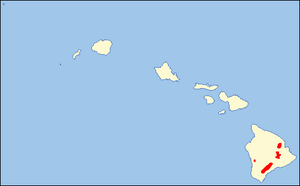Hawaiʻi ʻakepa facts for kids
Quick facts for kids Hawaiʻi ʻakepa |
|
|---|---|
 |
|
| Conservation status | |
| Scientific classification | |
| Genus: |
Loxops
|
| Species: |
coccineus
|
 |
|
| Range of L. coccineus | |
| Synonyms | |
|
Loxops coccineus coccineus |
|
The Hawaiʻi ʻakepa (Loxops coccineus) is a small, special bird. It lives only on the Big Island of Hawaiʻi in the Hawaiian Islands. This bird is currently endangered, which means there are not many left.
Scientists first learned about the Hawaiʻi ʻakepa during Captain James Cook's third trip around the world. This was a long time ago! People in Hawaii also used their colorful feathers to make beautiful leis (necklaces). The bird's scientific name, Loxops coccineus, means "crossed" (Loxops) and "red" (coccineus). This name describes its unique beak and the bright color of the males.
Contents
What the Hawaiʻi ʻakepa Looks Like
This bird is about four inches (10 cm) long. It has dusty green feathers. But the males are much brighter, with a fiery orange color!
One special thing about the Hawaiʻi ʻakepa is its beak. It has a small, crossed bill, just like other birds in the Loxops family. Its call is a soft, shaky whistle that ends with a long, rolling sound.
Where the Hawaiʻi ʻakepa Lives
The Hawaiʻi ʻakepa lives in only a few places on the Big Island of Hawaii. You can find them in the Hakalau Forest National Wildlife Refuge. There are also some in the higher forest areas of Kaʻū. A small group might still live on the northern side of Hualālai mountain.
In the year 2000, there were about 14,000 Hawaiʻi ʻakepa birds left. Because their numbers are so low, they were officially listed as an endangered species in 1975.
What the Hawaiʻi ʻakepa Eats
The Hawaiʻi ʻakepa loves to eat spiders and other small insects. It also drinks sweet nectar from several kinds of flowers. These include the ʻōhiʻa flower, the naio, and some types of lobelia flowers.
Reproduction and Life Cycle
Hawaiʻi ʻakepa birds have their breeding season in the spring. These birds are very special because they are the only ones in Hawaii that must build their nests inside natural holes in trees.
Most birds in Hawaii don't make holes in trees big enough for nests. So, the ʻakepa has to find holes that are already there. These natural holes are usually found only in very large, old trees. This means the ʻakepa needs old forests to survive.
Even though they are small birds, they don't lay many eggs. Usually, they lay only one or two eggs. Other birds their size often lay three to five eggs.
Threats: Diseases
The Hawaiʻi ʻakepa birds that are still alive live only in old forests high up in the mountains. These forests are usually above 1,200 meters (about 4,000 feet). This is because diseases like avian malaria and avian pox have harmed bird populations at lower elevations.
These diseases came to Hawaii when the first mosquitoes arrived in 1826. Since then, these diseases have caused more than 20 bird species in Hawaii to disappear. Diseases are still a big threat. If Hawaii's climate gets warmer, or if new bird diseases or mosquito types arrive, the ʻakepa could be in even more danger.
Threats: Losing Old Forests
Because they need tree holes for nesting, ʻakepa birds rely on old ʻōhiʻa and koa forests. Even though many ʻakepa live in protected areas, large trees seem to be falling faster than new ones can grow big enough.
It's not clear how people can help with this problem right now. One idea is to use special nest boxes made by humans. Some past studies showed that birds sometimes used these boxes, and their nests were successful. However, there isn't much ongoing research or use of these nest boxes for the ʻakepa today.
See also



